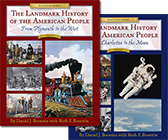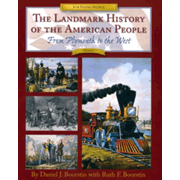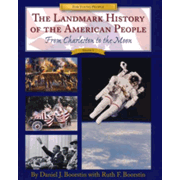The original version of The Landmark History of the American People was written by Daniel Boorstin, a historian and former Librarian of Congress, with assistance from his wife Ruth. It was published in 1968 and 1987. John Holzmann, cofounder of Sonlight Curriculum, Ltd., has written a new version based on the original book to make it more practical to use and more visually appealing. The new version is also titled The Landmark History of the American People.
Published as a two-volume series, it might be used with students as young as fourth grade and up through high school. On their website, Sonlight shows it as appropriate for grades three through six, but the two volumes together are equivalent in the amount of text and most of the topics covered to many high school level texts for United States History. Because of this, I am hesitant to recommend it for fourth graders, much less third graders, even as a read aloud. However, it should be great for fifth through eighth grade students.
The books are heavily illustrated, and the illustrations are of a higher caliber than we find in many texts. Many historical painting, drawings, cartoons, and photographs, are mixed with what appears to be custom artwork created for these volumes. Because they are printed on higher quality paper, the books are fairly heavy—the slightly larger, second volume weighs almost two pounds.
In his revision, Holzmann had two main goals: “simplifying and activating the language” and “adding maps, timelines, and illustrations.” Both goals support an effort to make The Landmark History of the American People more accessible to younger students. Publishing the book as two volumes makes the amount of material less overwhelming than it would be in a single book. (Earlier editions were published both as a single volume and as two-volume sets.) In this new version, the first volume has 169 pages and the second 254—a large number of pages in all. The two volumes might be used over two years or they might both be completed in a single year.
Part of the reason there is so much content is that The Landmark History of the American People includes more of the “back story” and connections than does a typical history book. Daniel Boorstin’s breadth of knowledge is evident as he tells the stories behind historical events. For example, he explains why the Navigation Acts passed by the British Parliament so irritated the American colonists. Then he further explains how the Navigation Acts also caused smuggling and piracy, especially benefitting the city of New York where pirate booty was easy to trade and sell. He elaborates, for example: “Captains and officers of privateers wore bright clothes. They were loud and hot-tempered. And they spent lots of money. They helped make New York a giant, rich, and colorful city” (Vol. I, p. 30).
The history places more emphasis on social developments than wars, so students develop an understanding of how and why things came to be. For example, the chapter “Everybody Shares the News” opens with stories about the various means of communicating news before the Civil War—newspapers delivered by slow mail, semaphores that would relay messages, and carrier pigeons. It then introduces Samuel F. B. Morse and tells the story of the development of the telegraph over the next two pages. The telegraph increased the quantity and quality of news, giving a big boost to newspapers and press services. As newspapers grew, presses improved, first with the development of flatbed presses and then the speedier rotary press. The chapter concludes with an interesting, but odd, statement that indirectly points out that the American people had become less religious: “Sunday newspapers…became big enough to fill the whole day for Americans who did not go to church” (Vol. II, p. 124). The entire chapter flows as a story about changing methods of communication and their impact on American business, politics, and culture.
The entire book seems to give more attention to progressive reformers and social justice topics than to religion. The Puritans and the Quakers get a bit of attention early in the first book, but there’s not much mention of religious belief after that. The Quakers are discussed largely in light of their pacifism in the colony of Pennsylvania where their refusal to defend the colony against the French and Indians resulted in many deaths before the British came to their defense. The tone is not anti-religious, but it tends to be more pragmatic and humanitarian, praising the work of reformers like Jane Hull who helped the needy through Hull House and President Theodore Roosevelt, both for his conservation efforts and for siding with workers against mine owners and big business. On the other hand, there’s no mention of The Great Awakening or other major religious developments.
The political tone seems slightly left of center. Discussion of FDR includes a positive take on the New Deal. Chapter 25 concludes with a paragraph that illustrates the general attitude throughout the book: “After Theodore Roosevelt, fewer Americans believed it was good enough for the government to be only an umpire. Even in a prosperous democracy, the powers of different citizens and corporations were not equal. In the twentieth century, more and more Americans expected their government to be a guardian. They expected it to help protect the weak from the strong” (Vol. II, p. 165). Families with a conservative viewpoint should not reject The Landmark History of the American People because of this. In many ways it provides a very well nuanced treatment of history lacking in so many other texts.
Unfortunately, there are no questions in The Landmark History of the American People textbooks and no teacher guides. However, parents might use a Charlotte Mason approach, requiring narrations as children read or listen to the text. Of course, parents can also create their own questions or assignments on their own, but that is extra work.
I realize that many parents find it difficult to use resources like this without questions and answers or a teacher's guide. Sonlight Curriculum includes use of the two Landmark History volumes in their Core D and Core E packages respectively as well as the in their condensed Core D&E guide that covers both volumes in one year. In the Core guides, notes for parents, questions, and answers sometimes help to expand and challenge ideas presented within The Landmark History of the American People. For example, in the Core D&E guide where it covers the chapter that includes the New Deal, it includes an open-ended discussion question regarding the expansion of federal agencies and programs as well as the contrast between Democrats and Republicans on this point. In addition, The Core D&E guide also has students read about this same topic from at least one other source followed by discussion. Similarly, the minimal amount of religious coverage in The Landmark History of the American People is more than offset in the Core guides by the use of other resources. Since Sonlight's Core guides fill the need for both ancillary items and more well-rounded coverage of topics of concern to conservative Christians, you might consider using The Landmark History of the American People with Sonlight’s Core guides.
Whether or not you use Sonlight’s guides, The Landmark History of the American People offers an outstanding option for the study of United States History with both excellent content and style.











